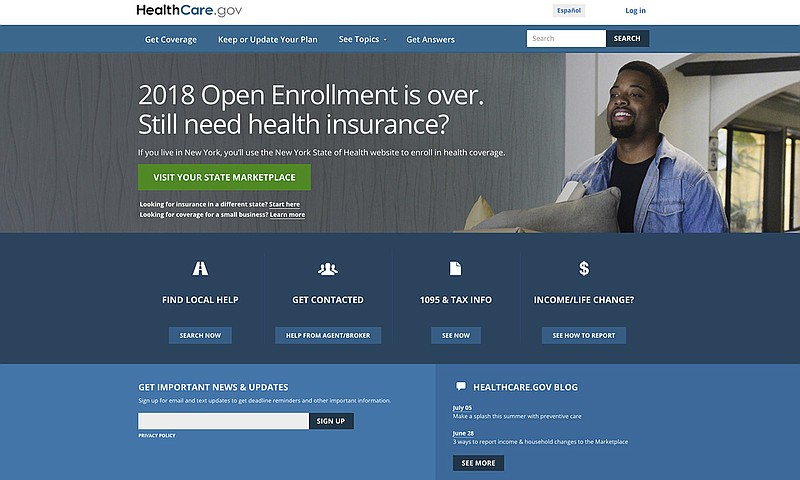Enrollment for the individual health plans for 2019 begins Thursday and, for the first time in Tennessee, the prices charged by health insurance companies in the program will decline from their current level.
For those signing up for individual health care coverage and not receiving any premium subsidies under the Affordable Care Act, or Obamacare, the monthly fees in Tennessee will drop for most plans.
Tennessee's largest health insurer, the Chattanooga-based BlueCross BlueShield of Tennessee, is cutting its individual plan rates next year by an average of 14.8 percent. Cigna Healthcare is cutting premium rates by an average of 12.9 percent.
But not all subscribers to individual plans will end up paying less in 2019 under Obamacare.
Where to get help
Sign up for individual health plans at www.healthcare.gov
"Due to the way the federal government sets these subsidies, many members who have zero dollar or low-cost premiums Thursday may actually see an increase in their monthly costs next year," said Kelly Paulk, vice president of product strategy and individual markets for BlueCross. "The short explanation is that your subsidy amount may drop by more than the amount your premium goes down. That means the amount you pay after premium subsidies may be higher in 2019."
Under Obamacare, the maximum percentage of a person's income that should go to health coverage is capped. For an individual earning $30,150 (or 2.5 times the federal poverty rate), the person should spend more than than 8.1 percent of his or her income, or $203.51 per month.
A 30-year-old resident of Jackson, Tenn., in such a scenario would get $564.39 a month in subsidies to pay for health insurance. But if the cost of the coverage goes down so does the subsidy, and the individual with comparable income next year will end up having to spend about $33 more for coverage.
"The fact that a decrease in rates can result in an increase in what consumers may pay points to the complex rules of the ACA Marketplace," Paulk said.
The ACA expanded coverage to millions of Americans when it established state-based marketplaces where people can buy a plan if they don't get insurance through work or qualify for government programs like Medicaid. But the expansion has been rough.
Much of the insurance being sold for Obamacare plans next year limits patients to narrow networks of hospitals or doctors and provides no coverage outside those networks. Plus these plans can still be unaffordable for people who don't receive help from the ACA's income-based tax credits, and they often require patients to pay several thousand dollars toward their care before most coverage starts.
"People understand that things are kind of screwed up," said Chicago-area broker Robert Slayton. "My objective is to give them what reality is, to give them options. Their job is to choose what may work."
Several insurers pulled back from these markets after being swamped with higher-than-expected costs. Many that remained jacked up prices or started limiting the hospitals and doctors included in their coverage networks.
Those narrow networks give insurers leverage to negotiate better rates that can lead to lower coverage prices, and the consulting firm McKinsey & Co. has found that the quality of their hospitals is comparable to broader networks.
Plans with narrow networks will cover necessary specialists like cardiologists, but they often exclude out-of-state care providers or academic medical centers, which tend to be more expensive.
Plans with some form of a limited network made up more than half of the choices offered for 2017 on the ACA's marketplaces, according to the latest numbers from McKinsey. That coverage was particularly common in the price range where most consumers shop, which is within 10 percent of the lowest-priced plan.
These plans grew more common from 2014 to 2017, especially in cities where insurers could choose between competing hospital networks. But that trend has since stabilized, said McKinsey's Jim Oatman.
Even so, brokers aren't expecting narrow networks to go away.
The narrow networks are grouped by hospital systems, and broker Kelly Rector has several customers who see doctors in different systems. She advises them to pick their coverage based on which doctor is most important and drop the others for in-network options.
Plans with narrow networks can make it harder to simply get to the doctor, especially if it's a specialist.
Narrow-network plans with their lower prices can be good for shoppers who aren't tied to a doctor and just want protection from big medical bills, said Paul Rooney, a vice president with the online insurance broker eHealth.
"They're younger and they're healthier and they're thinking, 'I'm going to get this coverage in case I hurt my knee playing basketball,'" he said.
But it can be tough for consumers when shopping to know if there's a decent selection of doctors nearby until they need one.
People who "have the most to lose from having a narrow-network plan are those who have something unexpected happen to them," said Daniel Polsky, a University of Pennsylvania economist.
